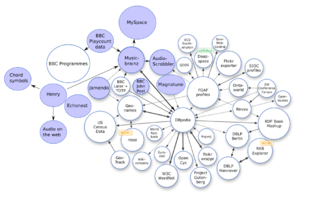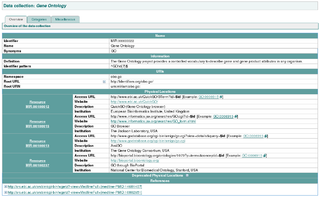In computing, a computer file is a resource for recording data on a computer storage device, primarily identified by its filename. Just as words can be written on paper, so too can data be written to a computer file. Files can be shared with and transferred between computers and mobile devices via removable media, networks, or the Internet.

The Dublin Core, also known as the Dublin Core Metadata Element Set (DCMES), is a set of fifteen main metadata items for describing digital or physical resources. It was the first metadata standard for describing web content. The Dublin Core Metadata Initiative (DCMI) is responsible for formulating the Dublin Core; DCMI is a project of the Association for Information Science and Technology (ASIS&T), a non-profit organization.

The Semantic Web, sometimes known as Web 3.0, is an extension of the World Wide Web through standards set by the World Wide Web Consortium (W3C). The goal of the Semantic Web is to make Internet data machine-readable.
The Resource Description Framework (RDF) is a World Wide Web Consortium (W3C) standard originally designed as a data model for metadata. It has come to be used as a general method for description and exchange of graph data. RDF provides a variety of syntax notations and data serialization formats, with Turtle currently being the most widely used notation.

This page is a glossary of library and information science.
UNICORE (UNiform Interface to COmputing REsources) is a grid computing technology for resources such as supercomputers or cluster systems and information stored in databases. UNICORE was developed in two projects funded by the German ministry for education and research (BMBF). In European-funded projects UNICORE evolved to a middleware system used at several supercomputer centers. UNICORE served as a basis in other research projects. The UNICORE technology is open source under BSD licence and available at SourceForge.
A web resource is any identifiable resource present on or connected to the World Wide Web. Resources are identified using Uniform Resource Identifiers (URIs). In the Semantic Web, web resources and their semantic properties are described using the Resource Description Framework (RDF).

MIRIAM is a community-level effort to standardize the annotation and curation processes of quantitative models of biological systems. It consists of a set of guidelines suitable for use with any structured format, allowing different groups to collaborate and share resulting models. Adherence to these guidelines also facilitates the sharing of software and service infrastructures built upon modeling activities.

Open data is data that is openly accessible, exploitable, editable and shared by anyone for any purpose. Open data is licensed under an open license.
In computing, computer performance is the amount of useful work accomplished by a computer system. Outside of specific contexts, computer performance is estimated in terms of accuracy, efficiency and speed of executing computer program instructions. When it comes to high computer performance, one or more of the following factors might be involved:
Resource refers to all the materials available in our environment which are technologically accessible, economically feasible and culturally sustainable and help us to satisfy our needs and wants. Resources can broadly be classified according to their availability as renewable or national and international resources). An item may become a resource with technology .The benefits of resource utilization may include increased wealth, proper functioning of a system, or enhanced well. From a human perspective, a regular resource is anything .To satisfy human needs and wants. From a

In economics, scarcity "refers to the basic fact of life that there exists only a finite amount of human and nonhuman resources which the best technical knowledge is capable of using to produce only limited maximum amounts of each economic good." If the conditions of scarcity didn't exist and an "infinite amount of every good could be produced or human wants fully satisfied ... there would be no economic goods, i.e. goods that are relatively scarce..." Scarcity is the limited availability of a commodity, which may be in demand in the market or by the commons. Scarcity also includes an individual's lack of resources to buy commodities. The opposite of scarcity is abundance. Scarcity plays a key role in economic theory, and it is essential for a "proper definition of economics itself".
"The best example is perhaps Walras' definition of social wealth, i.e., economic goods. 'By social wealth', says Walras, 'I mean all things, material or immaterial, that are scarce, that is to say, on the one hand, useful to us and, on the other hand, only available to us in limited quantity'."
A file format is a standard way that information is encoded for storage in a computer file. It specifies how bits are used to encode information in a digital storage medium. File formats may be either proprietary or free.

Metadata is "data that provides information about other data", but not the content of the data itself, such as the text of a message or the image itself. There are many distinct types of metadata, including:
The Handle System is the Corporation for National Research Initiatives's proprietary registry assigning persistent identifiers, or handles, to information resources, and for resolving "those handles into the information necessary to locate, access, and otherwise make use of the resources".
The biocapacity or biological capacity of an ecosystem is an estimate of its production of certain biological materials such as natural resources, and its absorption and filtering of other materials such as carbon dioxide from the atmosphere.

The MIRIAM Registry, a by-product of the MIRIAM Guidelines, is a database of namespaces and associated information that is used in the creation of uniform resource identifiers. It contains the set of community-approved namespaces for databases and resources serving, primarily, the biological sciences domain. These shared namespaces, when combined with 'data collection' identifiers, can be used to create globally unique identifiers for knowledge held in data repositories. For more information on the use of URIs to annotate models, see the specification of SBML Level 2 Version 2.
A human resources management system (HRMS) or Human Resources Information System (HRIS) or Human Capital Management (HCM) is a form of Human Resources (HR) software that combines a number of systems and processes to ensure the easy management of human resources, business processes and data. Human resources software is used by businesses to combine a number of necessary HR functions, such as storing employee data, managing payroll, recruitment, benefits administration, time and attendance, employee performance management, and tracking competency and training records.
Social Networks and Archival Context (SNAC) is an online project for discovering, locating, and using distributed historical records in regard to individual people, families, and organizations.
This glossary of computer science is a list of definitions of terms and concepts used in computer science, its sub-disciplines, and related fields, including terms relevant to software, data science, and computer programming.







